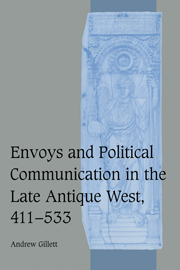Book contents
- Frontmatter
- Contents
- List of tables
- Preface
- List of abbreviations
- Chronological table
- Maps
- 1 EMBASSIES AND POLITICAL COMMUNICATION IN THE POST-IMPERIAL WEST
- 2 THE PROVINCIAL VIEW OF HYDATIUS
- 3 THE HERO AS ENVOY: SIDONIUS APOLLINARIS' PANEGYRIC ON AVITUS
- 4 THE SAINT AS ENVOY: FIFTH- AND SIXTH-CENTURY LATIN BISHOPS' LIVES
- 5 CASSIODORUS AND SENARIUS
- 6 NEGOTIUM AGENDUM
- CONCLUSION
- Appendix I Chronology of Constantius, Vita Germani
- Appendix II Chronology of the life of Epiphanius of Pavia
- Appendix III Senarius' Letters of Appointment: Cassiodorus, Variae IV, 3 and 4
- Appendix IV The text of Senarius' Epitaph
- Note on editions, commentaries, and translations of major sources
- Bibliography
- Index
- Cambridge Studies in Medieval Life and Thought Fourth series
Preface
Published online by Cambridge University Press: 12 July 2009
- Frontmatter
- Contents
- List of tables
- Preface
- List of abbreviations
- Chronological table
- Maps
- 1 EMBASSIES AND POLITICAL COMMUNICATION IN THE POST-IMPERIAL WEST
- 2 THE PROVINCIAL VIEW OF HYDATIUS
- 3 THE HERO AS ENVOY: SIDONIUS APOLLINARIS' PANEGYRIC ON AVITUS
- 4 THE SAINT AS ENVOY: FIFTH- AND SIXTH-CENTURY LATIN BISHOPS' LIVES
- 5 CASSIODORUS AND SENARIUS
- 6 NEGOTIUM AGENDUM
- CONCLUSION
- Appendix I Chronology of Constantius, Vita Germani
- Appendix II Chronology of the life of Epiphanius of Pavia
- Appendix III Senarius' Letters of Appointment: Cassiodorus, Variae IV, 3 and 4
- Appendix IV The text of Senarius' Epitaph
- Note on editions, commentaries, and translations of major sources
- Bibliography
- Index
- Cambridge Studies in Medieval Life and Thought Fourth series
Summary
This study sprang from several coincidences. I chanced to read Hydatius, Priscus, and Senarius' Epitaph (tucked away in the indexes of Mommsen's edition of Cassiodorus) at much the same time, and was struck not only by the importance of ‘diplomacy’ to all three texts, but also by the fact that while diplomatic communication was a prominent feature in modern literature on the Byzantine East, it was not much evident in studies of the early medieval West. At much the same time, we were all wakened each morning by radio news of the ‘shuttle diplomacy’ preceding the Gulf War of January–February 1991. These tense events suggested parallels with the repeated embassies in Hydatius, and with Senarius' boast of visiting eastern and western capitals twice within one year; more significantly, they focused the mind on the interconnectedness of communication and warfare. Some time later I began to research ‘diplomacy in the West’, but soon became convinced that the fragmentary nature of the sources precluded any meaningful ‘diplomatic history’ of the period, if the purpose of such a history was to gain insight into what our sources call the arcana and secreta of the imperial and royal courts. The most expansive sources tend to describe the policy intentions of the centres of power at best superficially and very rarely with any real claim to insider knowledge; what they are interested in is the importance of embassies to the careers of envoys themselves, or to their local communities.
- Type
- Chapter
- Information
- Publisher: Cambridge University PressPrint publication year: 2003

